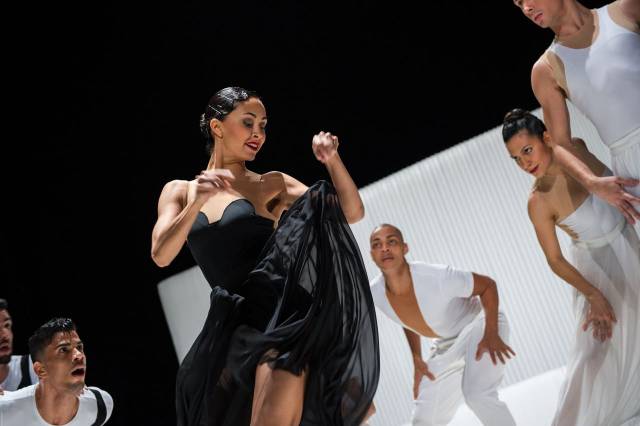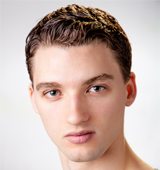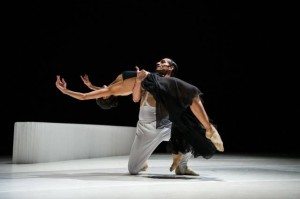

Ballet Hispanico's New York season, running April 14-26, includes the acclaimed full-length contemporary work CARMEN.maquia choreographed by Gustavo Ramírez Sansano. I spoke with the leads, Christopher Bloom and Kimberly Van Woesik, to find out more about what seemed to me like a big undertaking. Sure enough, the two have come a long way: They may have been elbowing each other in the face in the beginning, but now they are ready to wow us with their execution of exacting choreography and to tell this iconic tale.
CARMEN.maquia will be making its Joyce premiere this Tuesday. What new information will you be performing with that you didn’t have or that has changed since performing at the Apollo last year?
Christopher Bloom: [There has been time] to develop this character on the experiences that I've had more deeply and to distance myself from the way I've seen this role performed by another dancer. It was created on the Luna Negra Dance Theatre and first premiered at the Harris Theater in Chicago [in 2012], and I learned from the video. I learned from watching another dancer do it and at the Apollo, my performance was very much informed by his interpretation. Now, I've been able to form my own interpretation more clearly, in the sense that I play Don José -- a self-possessed, sure-of-himself man -- as older than I actually am. I'm only 24 years old but I try to portray the character as being about thirty or so, because he's an officer in the military and comports himself as such. Other information I have is just a lot of experience -- a lot of time doing the movement and working on incredible nuance. See, the thing is, the style of Gustavo's choreography is extremely dense. It's easy to accidentally do it just with movement, but if you slow it down and actually look at each of the movements, they are like words in a sentence. So, what I've been spending a lot of time doing is just that: slowing everything down and defining what each word means in each of these sentences and in each of these paragraphs that make up this dance.

Kimberly Van Woesik: That's interesting because I think the biggest difference for me is that I feel that I have settled into the role of Carmen and who she is a little bit more. I've had a lot of time since the Apollo to let that sink in so I'm more comfortable with the choices I'll be making on stage that I wasn't so sure about when we first performed it. The biggest difference for me will be the character development that's happened since the Apollo, through all the rehearsals that we've had up to opening night, and hopefully each night we'll grow more and more. I definitely feel more confident than I did before, and hopefully it shows on Tuesday night.
From what I understand, this ballet is very much inspired by Pablo Picasso. Can you tell me a bit about how you see that inspiration come through?
Christopher: Part of the research for the scenic design, costume design, and movement was examining Picasso's works -- mostly pencil drawings that were inspired by the character of Carmen -- and from Bizet's opera. I believe that was part of the research for the set designer, costume designer, and choreographer as well. This ballet has white, it has black, it has red lipstick, and it has blue blood. Those are the only colors that exist in the design. The reason is that, with the exception of red, those were the only colors Picasso used in his drawings: black, white, and blue.
Kimberly: Obviously the set, the design, the costumes, the color scheme... It's very simple but with the dancing, it's very abstract and at the same time, Gustavo's movement isn't always literal. I think, in that sense, the audience is able to formulate their own opinion about how they feel about what they're watching the same way you would look at a Picasso painting. How does it make you feel? It's not always black and white, you know?
From what I've seen of the movement in video clips, it appears to be sharp, angular, geometric, and obviously very fast. How would you describe the feel of the movement?

Christopher: It is sharp; it is geometrical, but if you look closely, one of the things Gustavo is after is obtaining different qualities of movement while moving at a very rapid pace. One movement might be quite staccato while the next might have an extremely round feel in order to give texture and at times add flow while at other times break up the flow of movement. One thing you will see a lot (if you're watching closely because it comes quick) is gestural. A lot of it is based on human communicative gestures.
Kim, can you tell us about your experience with the movement?
Kimberly: Well, you're right, it is so fast. I remember when I first watched the video I was thinking: Oh my god! It looks like they're on fast forward! It literally looked like someone pressed fast forward, but I was so excited to learn it. In the process of learning it, we just learned it and didn't set it to any music at all, which is kind of mind blowing when you think about it because Gustavo's work is so musical... it's all about the music. So, learning without the music was a bit strange at first, but when you see how much movement you're doing in such a short amount of time, you realize you have to break down the movement slowly before you set it to the music. That's how I learned the entire ballet -- from my very first entrance to the end of the ballet with no music. Then little by little we started to play the music along, then we really broke it down matching the music with the movement. It's definitely challenging for me. It's challenging every night to make sure the movement is fulfilled, to make sure that it doesn't look frantic, because it is so fast, and to reflect the music in my body with the movement. That's something I'm constantly working on. I always have my headphones on listening to the music, trying to listen in new ways -- how can I bring out different notes using the movement and the musicality that I've been given. It's definitely challenging, but at the same time, those runs where the movement and the music happen simultaneously, it feels right. It feels perfect...like you are the music in a way. Something I try to ask myself is: how do I make it look slow, so that it doesn't look so fast all the time? How can I make it look smooth, slow, how can I accent moments that need to be accented? Also, really, how do I match the quality of the music?
Christopher: It's certainly fast, but one of the things that I love about this movement is that it makes sense in the body. It feels right. You don't have to force your way through it. In fact, you actually have to relax your way through it -- because it's so quick, but also because it makes sense with the way human bodies move. It's not forced onto the way we move, it's part of it.
What has the process been like working with one another?
Kimberly: I'm so thankful that I'm dancing with him. He is the most patient, responsive partner to work with. To work with someone that cares as much as you do, who is also pouring all their heart and soul into a role to make it come alive... It's just been an amazing process working with him. We talked a lot, even outside of work, about who these characters are and how we are to carry out the story. We definitely spent a lot of time talking about how do we not act these parts, but how do we really make them come alive. I think together we've really grown in learning how to play these roles. And, just like Don José and Carmen, there were definitely moments in the process where we would get a little frustrated, but we always came together in the end. Like in the beginning when we first started learning it and we were hitting each other and elbowing each other. It's so fast that if it's not in sync perfectly, somebody's getting an elbow to the nose, which happened many a time. But, I would not rather be dancing with anyone else in this role than Chris Bloom. That's for sure.
Christopher: We both, right from the beginning, felt that it was an incredible opportunity for us, but also felt the weight of it -- the importance of being able to portray these characters in this way. It's a big job. Rehearsal would be over, everyone would be going home, and Kim and I would usually stick around the studio for forty-five minutes or an hour talking about what we could do to improve what we're putting on stage.

What's your most enjoyable moment in these roles on stage together.
Christopher: Well, there're a lot of them because we spend so much time together on stage and because each of those times, something different is going on in the story. There's times that are flirty and times that are sexy, and those are really fun. But, there's one duet where my character fully believes that we are in love and that we are going to live happily ever after. That duet just feels good. That might be the moment that is my favorite because it feels nice, it flows, and we are working together in a way that we don't get to in other duets. The other duets are either competitive or outright combative.
Kimberly: Yeah, we call it the slow duet, because it's the only slow duet that we do. It's probably the time that she is most sensitive. She plays in and out of entertaining the fact the he is in love with her, he's overwhelmed with her. Sometimes she'll give him that satisfaction. At the same time, she remains heartless. That back and forth that she gets to play with him along with the movement is just seamless. It feels good, it's freeing, and I feel most carefree Carmen in that duet. In that duet is my favorite time to dance with Chris.
Ballet Hispanico's Joyce season (April 14-26) includes five performances of CARMEN.maquia (April 21-25). For more information, click here.
See Ballet Hispanico at the Joyce, April 14-26.